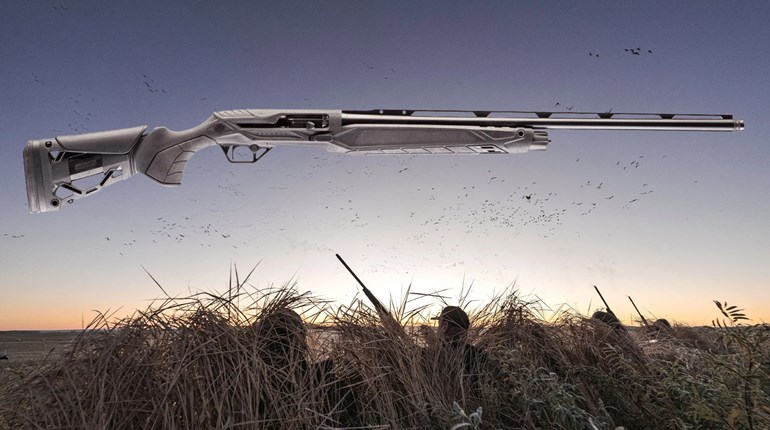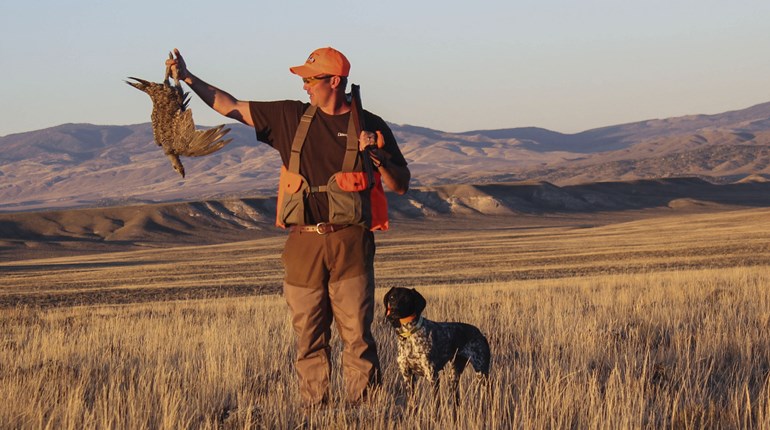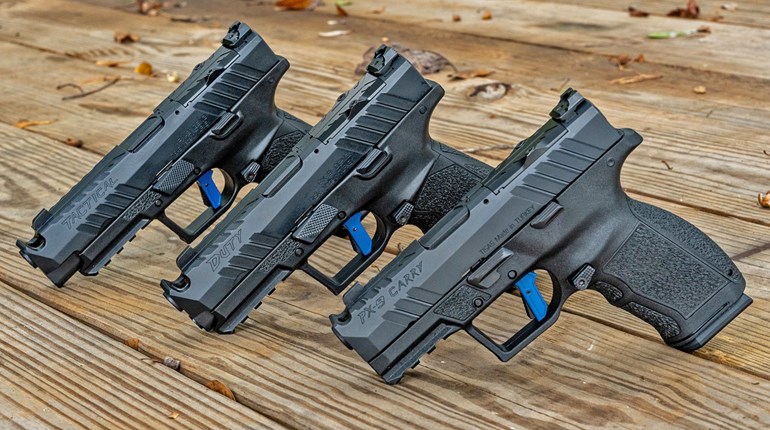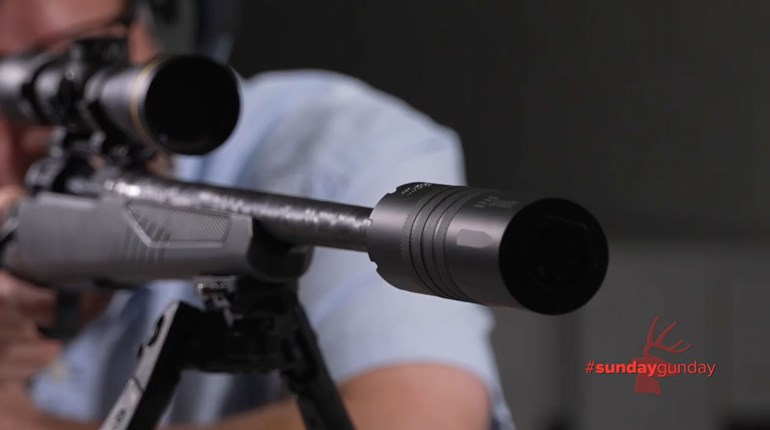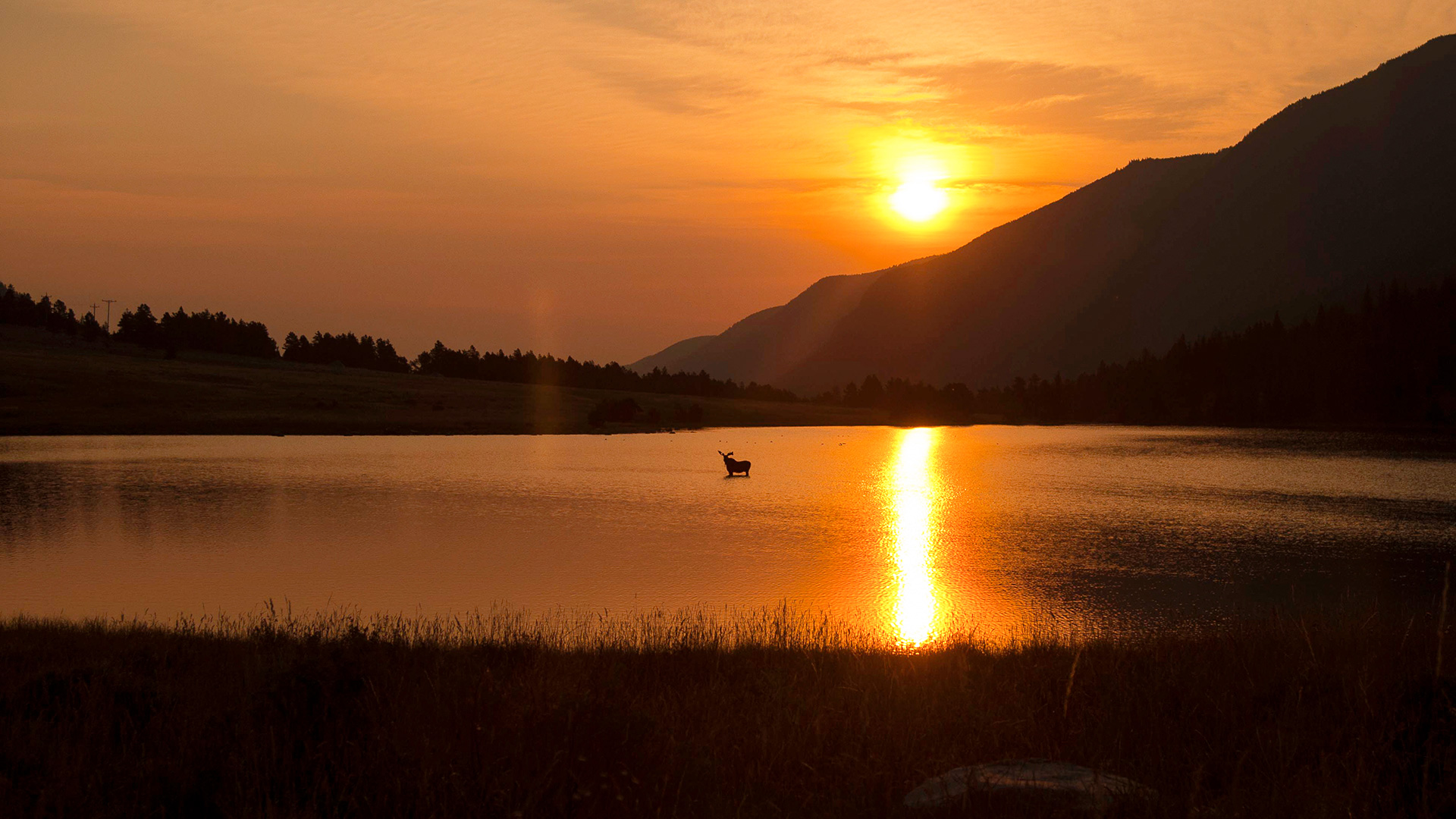
The meager contents remaining in the bait barrel and the faint outline of the print pressed into the dark earth indicated a large bear had been prowling Maine’s northern pine forests the night before our hunting party arrived. Ken Mayo of OMM Outfitters checked the trail camera that faced the suspended bait barrel, but with so many bears moving in and out of the area it was impossible to determine exactly which bruin had left the fresh prints in the black mud.
“There’s one bear about 150 pounds and one about 300 on the camera,” Mayo said. “They both came through about 3 in the morning.”
It was 9 o’clock in the morning when we found the track and that meant the bears had quite a head start. But we were joined by Rob Romm and his pack of skilled North Carolina bear dogs, and the leader of his pack was a Plott hound named Goodnight that possessed an exceptionally cold nose.
“We can put Goodnight on the trail and see what he does with it,” Rob said.
When Goodnight reached the bait he worked in a wide arc through the pines, his head low, his brindle coat blending with the shadows of the forest. A half-dozen bear trails led to the bait, and Goodnight trailed out on the path that led due north toward a large swamp. In a moment the dog was out of sight, and we watched his progress on the screen of the Garmin GPS handheld tracking device.

“He looks like he’s lining it out,” Rob said as we watched Goodnight’s triangular icon on the screen. “He’s covered 200 yards already.” The hound worked directly away from the bait in a straight line directly toward the swamp.
I’d hunted with Goodnight and Rob the day before, so I knew the hound was an exceptional trail dog. Old tracks that other dogs couldn’t follow read like a roadmap to Goodnight, who worked methodically along the bear’s trail and deeper into the swamp. I also knew that he was largely silent on the trail, so when the silence of the pine forest erupted in a long, deep chorus of howls I knew the bear was close.
“He must have jumped the bear,” Rob said. “It was laying in that swamp.”
Rob released his other hounds: a compact female Plott named Little Magic (in honor of one of Rob’s favorite dogs that had passed away a year earlier), another veteran Plott bear hound named Trump, and a lanky tri-colored treeing walker named Chase. All the dogs rushed through the trees toward the sound of Goodnight’s call, and in a moment the whole forest echoed with the roar of the pack at full voice on a fresh bear trail.
Ken, Rob, Browning’s Shaundi Campbell and I swung a wide arc around the forest on a rough logging road and came to a low bridge. The voices of the hounds, by then at full cry, were growing louder as the pack made its way directly toward us at a run. We’d just missed the bear as it crossed, but we arrived in time to see Little Magic and Chase erupt from the trees and clear the roadside ditch at full stride and in full chorus, with fresh bear scent ahead and thousands of years of hunting instinct behind them.
Chasing bears with hounds is just one of the hunting traditions that live on in Maine’s North Woods. While most traveling hunters head west in search of big game, the Pine Tree State might stand as the most underrated hunting destination in all North America. Here’s a look at a few of the adventures that await hunters there.
Moose: Maine is home to an estimated 60,000 to 70,000 moose, the highest population of any state outside Alaska. For the hunter who wants to hunt big bulls in the Lower 48 there’s little doubt that Maine offers the best opportunity.
“Moose tags in Maine are allocated by a random draw,” says Kenny Mayo. Kenny and his college friend Nathan Theriault started OMM Outfitters in Eagle Lake 20 years ago, and over time they have become the premier moose guides in northern Maine.
“We operate in units 1 through 6,” says Theriault. “Roughly 8 percent of the tags allocated each year go to nonresident hunters, and each year that you don’t draw you gain an extra point, which improves your odds.”
 Moose capital? In 2021, a hunter with Maine’s OMM Outfitters took a 65½-inch bull.
Moose capital? In 2021, a hunter with Maine’s OMM Outfitters took a 65½-inch bull.
Maine’s moose draw isn’t a sure thing, but if you are fortunate enough to land a tag you’ll be in a position to take a very good bull. The eastern Canada subspecies of moose is larger than the Shiras, and while Theriault says the objective is to take a bull with antlers ranging in spread from the mid-40s to upper 50s it’s possible to take a moose that’s much larger. In 2021 an OMM client took a bull with a whopping 65½-inch spread. A fully guided hunt with OMM costs around $7,000, which is considerably lower than the cost of moose hunts in other areas; Theriault says Maine’s accessibility is one reason so many hunters travel here for moose.
Hunting rutting bull moose in Maine is a thrilling experience. The most common method is to call bulls into rifle or bow range using a combination of cow calls and “raking” with a moose scapula on pine trees. Raking imitates the sound made by competing bulls thrashing their antlers on brush and trees, and it’s often enough to bring dominant males on the run as they seek out their unseen competitor. That means shots are often close and very intense.
Services like Worldwide Trophy Adventures can help clients apply for a Maine moose tag, but there are also a limited number of over-the-counter and governor tags available, though they increase the cost of the hunt. No matter how you land a tag, though, the experience of listening to a bull moose crashing through the willows and pines as he barrels toward you is not an experience you’ll ever forget.
Upland/Small Game: Big game is the primary focus for most Maine hunters, but the state offers lots of ruffed grouse and woodcock and vast tracts of public land upon which to hunt these birds.
“In many areas of the country, six to eight grouse flushes is a good day. Here you can expect 12 to 24 flushes a day with good dogs,” says Master Maine Guide Randy Flannery, owner of Wilderness Escape Outfitters in Danforth. “We also have a large population of resident woodcock, and migrating birds arrive in the fall. The grouse and woodcock hunting here on the Maine/New Brunswick border is truly phenomenal.”
Maine’s ruffed grouse population is estimated to be greater than 1.5 million birds, but the trick is finding birds in dense cover and getting a shot at them as they carve their way through the firs and pines in flight. During my first Maine grouse hunt I carried a fine Spanish side-by-side 12-gauge gun with 30-inch barrels, a firearm that was all but useless in the dense forests near Kokadjo. Since then I’ve switched to a 20-gauge with 24-inch barrels, which is more suited for hunting birds in heavy timber.
 In the heart of the state, goose hunters can find good luck in cut fields. An upland hunter in northern Maine can expect 12-24 grouse flushes per day.
In the heart of the state, goose hunters can find good luck in cut fields. An upland hunter in northern Maine can expect 12-24 grouse flushes per day.
Don’t miss an opportunity to chase snowshoe hares with beagles in Maine. The hare population here is subject to cyclical highs and lows, but with a good pack of hounds and a bit of fresh snow you’re likely to have a few good chases each day. Snowshoe hares run wide circles through the timber; you’ll have to listen for the sound of the hounds to estimate the hare’s path of travel. Trying to get in front of the chase is thrilling. Some of my best days in Maine have been spent following a pack of chortling beagles through the big pine woods. A $75 small game license will allow nonresidents to pursue upland birds and hares throughout the season.
Maine also has a large turkey population (estimated between 60,000 and 70,000 birds) and offers both a spring and fall hunting season. Apprentice hunting licenses in Maine include bear and turkey permits for residents ($26) and nonresidents ($115); hunters who are 16 and older and have never had a hunting license are eligible.
Black Bear: Black bear hunting in Maine is exceptional. Not only does this state have a high population of bears (around 35,000 and growing at a rate of 2-4 percent annually) but the state also produces some very large bears. The bears we hunted in Maine with Kenny Mayo and Rob Romm weighed between 150 and 275 pounds, which is good. But the week after our departure the duo led a client to a 441-pound bruin behind dogs. Color phase bears aren’t as common in Maine as they are in, say, Idaho or New Mexico, but Maine is certainly the premier bear-hunting destination in the eastern United States.
“We have very high bear densities in Maine,” Mayo said. “The hound season lasts for a month, and next year we’ll likely move to a two-bear limit.” Being able to hunt two bears would allow clients the opportunity to chase bears with dogs and to sit in a blind over bait. Since most hound hunting is done in the morning when tracks are fresh and the scent is strongest, and bait hunting occurs in the afternoon and evening, it’s easy to book a Maine bear hunt that allows you to experience both types of pursuits in a single week. Hunting with hounds may require long hikes over rough, uneven terrain but hunting bears over bait is a wonderful experience suitable for any hunter.
Prices vary by outfitter, but you can expect a Maine black bear hunt with bait to run from $2,000 to $3,500 while hound hunts are generally slightly more expensive. In addition to the $115 nonresident big game license, out-of-state hunters will also pay $74 for a bear hunting permit.
Waterfowl: Mossberg’s Linda Powell has had the opportunity to hunt all over the world, but one location that always draws her back is coastal Maine.
“I enjoy experiencing local culture, and hunting coastal Maine towns is always fascinating,” Powell says. “Of course, you’ll enjoy great seafood like fresh lobster while you’re there.”

While hunting sea ducks in Maine, Powell doesn’t use a guide service, but instead relies on local Ducks Unlimited volunteers who help her locate ideal locations for her hunts. Powell says that typically means sitting on a rock by the sea (something unfamiliar to most waterfowl hunters) and waiting for an opportunity at passing common eiders, white-winged and common scoters, old squaws and other sea ducks that aren’t found many other places in the United States. Hunting seagoing waterfowl from a rocky perch overlooking the ocean and dining on fresh lobster is an unforgettable experience (one made possible in part by organizations like Ducks Unlimited that have made preserving sea ducks a priority), but Powell says shooters need to know sea ducks are very tough.
“Keep shooting until you know the bird is dead,” Powell says. “Sea ducks oftentimes take off after they’ve been hit.”
Further inland Maine is home to exceptional duck and goose hunting as well. Early in the season you can expect mallards and wood ducks to be primary targets, and Maine is a prime location to take a black duck. Open fields can hold thousands of Canada geese that haven’t been pressured like birds farther south.
Whitetails: Maine has produced some enormous whitetails over the years including a 259-inch non-typical taken in 1910 by Hill Gould, the 1932/8-inch Potato buck (so named because it was taken while eating potato peelings in Aroostook County in 1965), and another Aroostook County giant estimated at 210 inches that was killed in 1949 by Fred Goodwin. And while there’s no doubt monster Maine whitetails still exist in strong numbers today, there’s a simple reason why the Pine Tree State doesn’t enjoy a better reputation for producing big bucks: whitetails are very hard to hunt in the North Woods. Deer can simply disappear here, but hunters who are willing to adjust their tactics to the terrain will find plenty of public land in Maine and ample opportunities for really big bucks.
“I grew up in a family of jump shooters,” says Randy Flannery.
“Jump shooting” is a time-honored hunting method in Maine that requires following the tracks of a buck in the hopes of eventually catching up to the animal and getting a shot. Flannery is considered one of the nation’s most skilled deer trackers, and he hosts seminars on the art of jump shooting deer at the annual NRA Great American Outdoor Show in Harrisburg, Pa.

“You need to know what to do if a buck sees you first and how to tell if a buck’s been chasing does all night and is heading to his bed,” says Flannery. “If the deer is moving from one doe group to the next you’ll probably never catch him.”
According to Flannery a skilled jump shooter will recognize how old the print is, the sex and approximate size of the deer (within 20 or 25 pounds) and much more by simply examining the track. But developing these skills takes a great deal of time. To hunt with a seasoned Maine jump shooter is an unforgettable experience.
Leave your long-barreled sendero rifle at home when hunting whitetails in Maine and pack your pistol-caliber lever-action, a semi-auto carbine or a bolt-action scout rifle instead. Shots will be close and fast, and a good-handling gun that is easy to maneuver through the dark forest is far more important than gilt-edge accuracy. A low-magnification optic or red-dot sight with a wide field of view is also a must-have item for this hunt (see sidebar). Maine’s nonresident firearm season begins Nov. 1.
Visit the Maine Department of Inland Fisheries & Wildlife at maine.gov/ifw/index.html.
Guns and Optics for Maine
While hunting Maine I carried Winchester’s XPR Stealth Suppressor Ready rifle ($719.99). With its 16.5-inch threaded barrel and overall length of just over 3 feet, the XPR Stealth is suitable for hunting in dense forests. The Winchester’s composite stock and Permacote metal finish stand up well to abuse.

The XPR’s two-position safety/bolt unlock button prevents the bolt from accidentally opening when it brushes against branches and limbs. I carried an XPR chambered in 350 Legend, a low-recoiling, low-cost cartridge that’s perfect for hunting deer and bear. If you want a more powerful cartridge for moose, the XPR is also chambered in .300 WSM or Winchester/Browning’s hot new 6.8 Western.

Bring a scattergun to Maine even if you’re hunting big game since you may find you have a free morning to spend shooting grouse and woodcock or following a pack of hare hounds through the woods. Winchester’s reliable SX4 semi-auto shotgun ($1,049.99) is suitable for hunting in dense cover, especially the 20-gauge model with a 24-inch barrel.

Quality optics are essential for hunting Maine’s dark timber. Leupold’s outstanding VX-5HD ($999.99-$1,999.99) scopes feature high-definition lenses that provide excellent clarity even in very low light when the largest bears come to bait. The FireDot Duplex reticle is easy to see, and there are a variety of magnification options from which to choose. The 3-15x44 I used worked for hunting bears over bait, but the 1-5x24 is a great choice for hunting bear over hounds or for jump shooting deer. VX-5HD scopes are very well built, and even with a price tag starting at a grand, they’re one of the best values in hunting optics.












